Probing the Definition of Yin and Yang in Our Body
Fang Hui (方輝) and Xiao Dangsheng (肖黨生)
The First Affiliated Hospital, College of Medicine, Zhejiang University, Hangzhou 310000, China
ABSTRACT The Yinyang theory and wuxing theory are the core parts in the field of Traditional Chinese Medicine (TCM).Giving the accurate definitions of the concepts of Yinyang and wuxing is essential for the modernization of TCM. Here,all metabolisms in our body are abstracted into two essential pathways: energy metabolism and stem cell proliferation& differentiation (SCPD) according to the principles of TCM and all of physical behaviors are the collective interaction of the two pathways. With the two pathways, a metabolic loop was discovered and all metabolisms in our body can be regarded as the oxidation of nutrition. Furthermore, the interrelationships of energy metabolism and SCPD have the same characteristics of Yin and Yang. So, we can coin that energy metabolism should be regarded as yang while SCPD should be regarded as yin.
KEYWORDS: Energy metabolism; Stem cell; Traditional Chinese Medicine; Yinyang
INTRODUCTION
Generations of researchers are fascinated in modernizing the Traditional Chinese Medicine (TCM).Up to date, there are several principle streams for this project. Most of researchers tried their best to find out biomarkers for diagnosis in the term of TCM1or to purify some biomolecules from the herb medicines for the treatment of certain diseases by utilizing modern biological techniques2. Many researchers presented their experiences in treating certain diseases with herb medicines or Chinese medicinal formula3,4. Some of researchers in TCM evaluated and treated the patients only in the paradigm of traditional Chinese medicine with a little consideration of physical parameters in modern medicine. However, only a few of researchers are making their efforts to combine the TCM and modern medicine by giving the definite biological understanding on the core theory in TCM5,6, just like Yinyang theory7, Wuxing theory8and so on.
In the field of TCM, Yinyang and Wuxing theories are the core parts with qi and xue as the essential concepts. Giving the accurate definitions of these concepts are perhaps the milestones for the modernization of TCM. In past, we had coined that Qi had the same characteristics as energy while the motivation of qi should be regarded as the flux of energy from the chemical energy to heat energy9. According to these understandings, we also presented our definitions about Yinyang and Wuxing theory in cell10,11. In fact, TCM theory should be used to help clinicians to give accurate evaluation and treatment to patients. In other words,it is the key milestone for modernization of TCM by presenting the physical understanding on the Yinyang and Wuxing theory in human body.
ENERGY METABOLISM AND STEM CELL PROLIFERATION & DIFFERENTIATION(SCPD) ARE TWO CORE METABOLIC PATHWAYS IN HUMAN BODY
The metabolism in human body
We had declared that energy metabolism in cell was the process that energy agents were oxidized into end metabolic products which should be regarded as an energy flux from chemical energy to heat energy10. In our body, there had a similar energy flux with the foods as the initial substrates. After being taken by our body, foods will be digested into energy agents such as monosaccharides,amino acids and fatty acids which will be transported to all cells in body for oxidation. After being oxidized,all energy agents will be transformed into end products which will be excreted by lung, skin, and kidney. This is the energy metabolism in human body and our body will get much energy from this energy flux for all biological function such as speaking, writing, running, heart beating,respiratory movement, action potential and so on. Now,it should be pointed out that cell is the functional and structural unit for the energy metabolism in our body and without cells, energy metabolism in our body cannot be carried out (Figure 1).
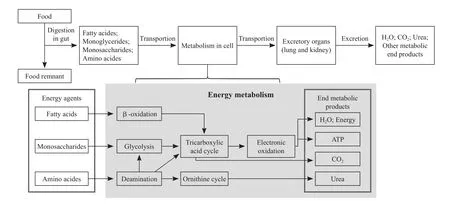
Figure 1. The energy flux in our body
Stem cell proliferation & differentiation in our body
It is estimated that there are about 400 kinds of the somatic cells in our body which will be used to construct all tissues and organs so as to complete biological functions. The life periods of most somatic cells are much shorter than expectative length of our body. For example,the life periods of neutrophils and intestinal epithelial cell are about 5 days while the life cycle of skin mucous cell is about 2~3 weeks. Red blood cell will live 120 days and lymphocytes can live several years. In human body,only nerve cells can live as long as our life expectancy.Somatic cells will execute their physiological function in their life cycle. After finishing their physiological function, somatic cells will die and then be degraded into amino acids, monosaccharides and fatty acid, which then undergo energy metabolism. At this time, the stem cells will produce new somatic cells by proliferation and differentiation to take the place of dead ones. Stem cells are undifferentiated cells with the capacity of in finite or long-term self-renewal and the ability to develop into one or more types of somatic cells. All stem cells can be classified into totipotent, multipotent or unipotent according to their potents for differentiation into different specialized cells12. A multicellular adult is derived from a fertilized egg, which consists of totipotent stem cells that can develop into all of the different forms of somatic cells by proliferation and differentiation (Figure 2).
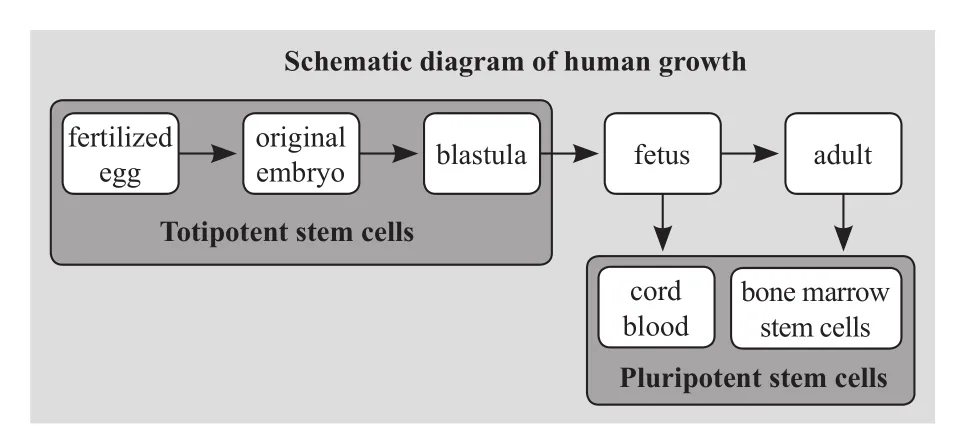
Figure 2. Schematic diagram of human growth
In the adult body, there are a number of mesenchymal stem cells (MSC) in tissues and organs,which can produce somatic cell by proliferation and differentiation to replace the dead cells. Mesenchymal stem cells are a population of tissue-resident adult progenitor cells that are originally identified in bone marrow, and have now been identified in many other organs. An MSC must express the cell surface proteins CD105, CD90 and CD73, but in addition, it must not express CD45, CD34, CD14/CD11b, CD79a/CD19 and human leukocyte antigen (HLA)-DR surface molecules13,14. Mesenchymal stem cells in bone marrow are more important than the others. Evidences have confirmed that bone marrow mesenchymal stem cells not only can differentiate into hematopoietic stromal cells,but also can migrate to other tissue to form the tissuespecific cells15,16.
So, it should not be denied that SCPD is a vital physical process in human body by producing all somatic cells to develop into a mature individual or to replace the dead one so as to keep the structure of tissue and organ stable. Although stem cell transplantation is an effective treatment for certain diseases, such as leukemia17, heart disease18,19, liver disease20,21, nervous system diseases22,23,and other happenings, there are no method to evaluate the state of SCPD in clinic. However, our opinion is that if no structure abnormalities are found in local tissues of an organ, the renewal of somatic cells is in normal state and SCPD keeps in order and B ultrasound, computer tomography (CT) and magnetic resonance imaging(MRI) are used to inspect the structure of organ. So, these instruments can partly be used to assess the state of SCPD in our body (Figure 3).
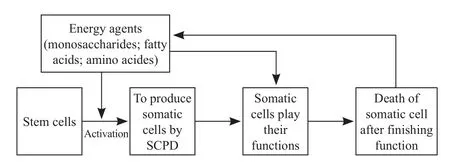
Figure 3. The SCPD in human body
Metabolic loop in our body
In our body, foods are the substrates both for energy metabolism and SCPD. When foods are taken, they will be decomposed into energy agents in intestine and then be assigned to the two pathways after being absorbed.During energy metabolism, the absorbed energy agents are transported to somatic cells for oxidation and produce end products. This can be named as the short metabolic pathway while all tissues and organs would get energy for their physical functions. When being assigned into SCPD,energy agents will surge the stem cells to synthesize proteins, which will be used to construct the structure of cell, and then stem cells are to be activated to produce somatic cell which will take the place of dead ones,keep the structure of tissues and organs stable, repair the damaged tissue and complete their physiologic functions.After having finished their functions, these somatic cells die and are to be decomposed to energy agents for energy metabolism. This can be regarded as a long metabolic path way in human body.
The long metabolic pathway is the combination of both SCPD and energy metabolism, and SCPD occurs first, followed by energy metabolism. Based on the long and short metabolic pathways, all metabolisms in human body construct a metabolic loop (Figure 4). Because of this metabolic loop, we can abstract all metabolisms in our body as an oxidation of foods and all physical behaviors are based on the loop.
THE INTERACTIONS OF ENERGY METABOLISM AND SCPD ARE THE SAME AS THAT OF YIN AND YANG IN TCM
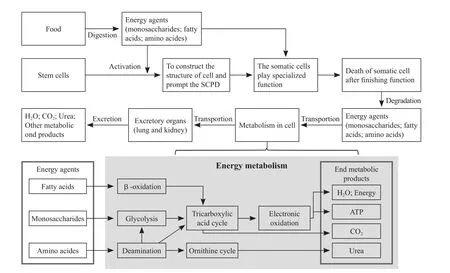
Figure 4. The long metabolism in human body
In the theory of TCM, all biological phenomena are originated from the interactions of Yin and Yang which are abstracted as following: interdependence between Yin and Yang; opposition of Yin and Yang; wane and wax between Yin and Yang; mutual transformation between Yin and Yang. Energy metabolism and SCPD are also the core processes in our body while all biologic appearances are the collective behaviors of energy metabolism and SCPD. We have presented that Qi had the same characteristics of energy and our opinion is that energy metabolism in our body should be regarded as Yang while the SCPD should be regarded as Yin. The interactions of energy metabolism and SCPD can also be abstracted as that of Yin and Yang.
Interdependence between yin and yang:interdependence between energy metabolism and SCPD
Although energy metabolism and SCPD are the essential processes in our body, any of them can not undergo independently. Energy metabolism is a kind of energy flux and all of organs in our body are organized for this process. For example, foods are digested and absorbed in gastrointestinal system. Neuroendocrine system regulates the distribution of these agents and oxygen while metabolic end products will be transported to kidney, lung and skin for excretion. The organs and tissues are the bridges connecting the energy metabolism and SCPD. In case that the structures of all organs are in normal, the energy flux will not be disturbed. All organs are made of somatic cells, most of which has the life span and will be renewed by the process of SCPD. In case that SCPD is in order, the newborn somatic cells will just replace the dead cells and the structures of organs and tissue will be as usual.
On the other hand, without energy metabolism,SCPD cannot go on. Energy metabolism will play its effect on the SCPD by following ways. Firstly,by energy metabolism, stem cells will get sufficient energy agents for their survivals and mitoses. Secondly,when energy metabolism in our body is in order, the internal environment in our body is in normality, for stability of internal environment will afford pleasurable microenvironment for SCPD. Thirdly, as for stem cell,although bone marrow stem cells are regarded as the reservoir in our body, most of them must migrate to local tissues and organs for transforming to tissue-specific stem cells. Many organs attend the migration of stem cells,for example, the circulation system and neuroendocrine system, while the normality of energy metabolism will keep the function of these organs in order so that stem cell can migrate to local tissues easily.
Opposition of yin and yang: opposition between energy metabolism and stem cell proliferation and differentiation
Although the energy metabolism and SCPD are the undividable processes in our body, they are sometimes repulsive, for energy agents (monosaccharides, fatty acids, amino acids) are the same substrates for both processes.
All energy agents will be distributed into these two processes in human body after being absorbed. Among the restricted supply of energy substances, the more energy substances enter energy metabolism, the less enter the process of SCPD. Subsequently, the functions of tissues and organs will be increased with the decrease of renewal of somatic, and the structure of organ may be deconstructed because of lacking new somatic cells. The development of hypertension and atherosclerosis is the example. On the contrary, the more energy substances enter SCPD, the less enter energy metabolism. This will result in the accumulation of somatic cells with the decrease of organ function, just like polypus and in flammatory pseudo tumor.
Wane and wax between yin and yang: energy metabolism and SCPD can not only promote each other but also constraint at the same time
Supplement of energy substances is also the causative factor for wane and wax between energy metabolism and SCPD.
As abundant supplement of energy substances,energy metabolism and SCPD will promote each other.In such a situation, energy metabolism is speed up to improve the function of all organs, so stem cells, with pleasurable microenvironment, can easily migrate to local tissue and organ,and produce more somatic cell as well to take the place of dead cells. In turn, more somatic cells appear in local tissue, which make organ grow or hypertrophy and promote the metabolism of these organs.The growth of child with sufficient nutrition is a vivid example.
In contrast, if there is an insufficiency of energy suppliers, energy metabolism will decline and the function of organ will also be depressed. At this time, the process of SCPD will also decline due to an insufficiency of energy substrates. Subsequently, stem cell cannot produce enough somatic cell to replace the dead one and organ atrophy will be unavoidable. With the reduction of somatic cells, metabolism in organ will go on decreasing.Malnutrition and organ atrophy are the just examples.
Mutual transformation between yin and yang:shift in the dominant position between energy metabolism and SCPD
Although energy metabolism and SCPD are two elemental processes in human body, only one process is dominant and the other is inferior. When energy metabolism in human body is dominant,energy substances will be oxidized just to enhance the function of tissue and organ. Subsequently, more energy substances will be transported to activate stem cells. End metabolic products are to be excreted more rapidly and microenvironment maintains stable for SCPD. Neuroendocrine system and paracrine system will produce more hormones and cytokines to adjust SCPD. Gradually, stem cells are activated to proliferate and differentiate so as to overtake the energy metabolism as dominant state. This process is described in TCM like that yang is changing to yin.
When SCPD take the dominant state, more somatic cells will be produced. These somatic cells consume more energy substance to precede the metabolism and the function of tissues and organs are to be improved.Gradually, energy metabolism will take the dominate state. This process is described in TCM like that Yin is changing to Yang.
SUMMARY
Probing the nature of living entities is an important issue in biology. Perhaps, the integration of TCM and modern medicine will give some novel insights on this issue. In past, we had coined that are two essential pathways in cell according to the principles of TCM while all behaviors of a cell are built on the interactions of energy metabolism and gene output. Furthermore, all metabolisms in cell can be abstracted as an oxidation of energy agents while all organelle in cell were organized for this oxidation. The process of gene output was carried for the renewals of proteins in cell so as to keep the structures and functions of a cell in normality. As for the oxidation in cell, energy agents, oxygen, genes, the releases of end-products and heat are the five factors which have the effects on the oxidation while the relationships of the five factors will help us to understand Wuxing theory in TCM10.
With the same principle in TCM, we now have abstracted all metabolisms in our body into two essential pathways: energy metabolism and SCPD. Our body is composed of billions of cells which undergo the energy metabolism for themselves while all the cells in our body are organized for the energy flux in our body. It has been generally accepted that all biological behaviors are controlled by genes including the SCPD. So, the ideal should not be denied that genes will take the impacts on the behaviors and structures of our body by regulating the SCPD.
Just like a cell, the energy metabolism in our body can also be regarded as an oxidation of nutrition with the foods as substrates which are different in cell. In this energy flux from chemical energy to heat energy, there are five factors which will in fluence the undergoing of the flux: nutrition, oxygen, SCPD, releasing of heat energy and end-products. The relationships of these factors have the same characteristic of Wuxing and more researches should be carried out to demonstrate this ideal.
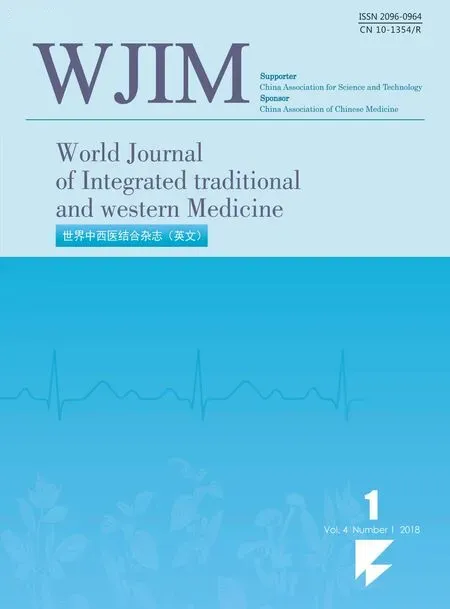 World Journal of Integrated Traditional and Western Medicine2018年1期
World Journal of Integrated Traditional and Western Medicine2018年1期
- World Journal of Integrated Traditional and Western Medicine的其它文章
- Therapeutic Effects of "Soothing the Liver Method" on Stress-related Non-alcoholic Fatty Liver on Neuroendocrine-metabolic Level
- New Year's Message
- Systematic Review and Meta-Analysis of Randomized Controlled Trials of Xianling Gubao Capsule as Adjuvant Treatment of Osteoporotic Fracture
- Analysis on the Pharmacists Intervention Results of the Problems from 2000 Prescriptions of Chinese Herbal Pieces
- A Life System Tuning Model
- A Systematic Review and Meta-Analysis of Herb-Partitioned Moxibustion in the Treatment of Primary Dysmenorrhea
